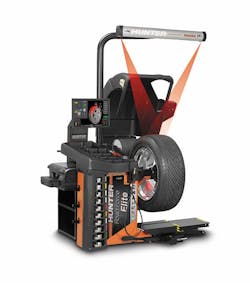Don’t assume your technicians know everything they need to about properly mounting and balancing ultra-high performance tires. The UHP tire and wheel package is too expensive to take for granted.
We asked Hennessy Industries Inc. and Hunter Engineering Co. to pinpoint the problem areas techs most often overlook when mounting and balancing UHP tires.
1. Centering the wheel on the balancer. “If you look at the leading cause of vibration-related comebacks, the number one issue is mounting error, specifically how the tech mounts and centers the wheel onto the balancer,” says Don Vanderheyden, Hennessy’s director of marketing. The solution to this problem? Using collets instead of cones; using adjustable pin plates (lug-centric mounting adaptors that are used in conjunction with the collets); and a quick nut to tighten the assembly or the shaft to secure it.
2.Road force balancing. High road force variation results are relatively common on UHP tire assemblies, says Greg Meyer, product manager for balancers at Hunter. Specialty UHP tires can have high road force variation, and wheels, especially lower quality aftermarket products, might not be round and will contribute to high road force variation. Improper lubrication is a common problem. “Tire lube issues can range from too little, too much, or the wrong type,” says Meyer. “We’ve seen it all from Windex to motor oil. From our testing we’ve found the best solution is to use a tire paste that comes in a bucket and is applied with a brush.”
Exercising tire beads after installation can significantly reduce road force variation. Meyer says bead massage, or bead exercising, “has a significant effect on average road force values.”3. Residual static unbalance. “Computer balancers on the market today will dynamically balance a wheel,” says Vanderheyden. “However, due to weight round-offs and slight weight placement errors, they can oftentimes leave an excessive residual static unbalance... resulting in a ride disturbance complaint.”
4. Improper wheel weight usage. Mounting and balancing equipment can tell the tech where the weights need to be attached. But are they the correct weights? Is too much weight being used? And despite the equipment, are they still being placed in the wrong place on the wheel? Hennessy research indicates improper wheel weight usage is the cause of improper balancing 7% of the time.
5. Wheel damage. It all comes down to the equipment. Meyer from Hunter says a lever-less tire changer with plastic head and rollers avoids metal-to-metal contact. Hennessy says using adjustable pin plates will help prevent damaging the front of the wheel. And a wheel lift on the mounting machine will prevent a tire from being slammed onto any surface, including the balancer itself.
6. Balancer calibration. “Depending on how often you calibrate, zeros on a balancer’s display do not always mean “balanced,” says Vanderheyden.
7. Reverse drop wheels. Handling reverse drop wheels when mounting tires requires a proper tire changer, as well as the right adaptors. ■
Ride that Hangs on the Balance
Hennessy Industries Inc. breaks down the causes of improper balancing as follows:
- Improper centering: 60%
- Residual static unbalance: 10%
- Improper wheel weight usage: 7%
- Drive train vibration: 6%
- Balancer calibration: 5%
- Eccentricity problem: 5%
- Improper lug nut torque: 4%
- Bent wheel rim: 2%
- Other: 1%
Included in “Other” is force variation at .05%.




